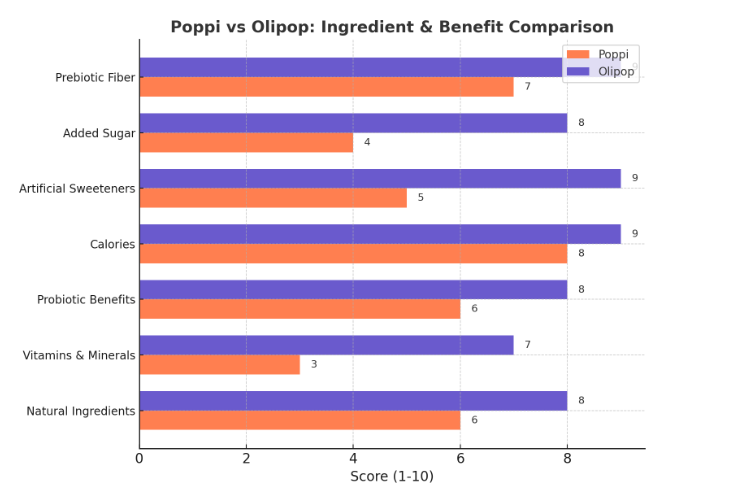Poppi vs. Olipop: Revealing the Secrets of the Health Soda Industry
See a full-scale comparison of the two biggest "Gut Soda" giants in the market today. Is there something these health food leaders are hiding from you?
GUT + GUARD
Hank Cramblin
8/8/20254 min read


Poppi vs. Olipop: Which “Gut Soda” Actually Helps Your Microbiome?
Gut + Guard — Naked Health
You’ve probably seen both on shelves and in influencer feeds: colorful cans promising the “soda you can feel good about.” But beneath the cheerful branding are two very different formulas, claims, and trade-offs. Here’s what matters if you care about gut health — not just trendy packaging.
Quick Ingredient Face-Off
Poppi (typical ingredients)
Sparkling water, cassava root fiber, organic cane sugar, apple cider vinegar, organic agave inulin, stevia leaf extract, fruit juice/concentrate (varies by flavor). Nutrition: ~25–35 kcal, ~2–3 g fiber, ~4–5 g sugar per 12 oz can (varies by flavor). poppi+1poppi+1
What to like: apple cider vinegar (ACV) is trendy for digestion and satiety; cassava and agave inulin are prebiotic fibers. Simple label — fewer exotic extracts. poppiPubMed
Red flags: added cane sugar in most flavors (3–5 g) and small fiber dose per can — likely insufficient to drive meaningful microbiome changes alone. Poppi faced a class-action settlement challenging its gut-health claims. EatingWellVerywell Health
Olipop (typical ingredients)
Carbonated water, OLISMART blend (cassava root fiber, chicory root inulin, Jerusalem artichoke inulin, nopal cactus, marshmallow root, calendula, etc.), cassava root syrup, allulose, stevia, natural flavors. Nutrition: ~45 kcal, ~9 g fiber, ~2–5 g sugar (varies), typically marketed as 9 g fiber per can. OLIPOP+1OLIPOP+1
What to like: higher fiber per can (clinically meaningful dose territory), multiple prebiotic sources (inulin types + resistant starches), plus botanicals that may support digestion and mucosal health. Allulose is a low-calorie sugar alternative with GRAS status from regulators. PubMedU.S. Food and Drug Administration
Red flags: more processing, more ingredient complexity (plant extracts that add benefits but also variability), and some people report bloating/GI discomfort when first increasing inulin/resistant starch. EatingWell
The Science: Do These Ingredients Actually Help?
Prebiotic Fibers (Inulin, Cassava fiber, FOS)
Prebiotics like inulin and fructo-oligosaccharides reliably increase beneficial bacteria (Bifidobacteria) in controlled studies and are linked to improved bowel regularity, better mineral absorption, and reduced markers of inflammation in some trials. But dose matters — many studies use grams of prebiotic fiber per day (often higher than a single can of Poppi). Olipop’s ~9 g per can is much closer to study doses than Poppi’s ~2–3 g. PubMedFood Science & Human Nutrition
Apple Cider Vinegar (Poppi)
ACV has small studies suggesting benefits for glycemic response and satiety, and it’s anecdotally helpful for digestion — but it’s not a prebiotic on the level of inulin. ACV is a unique marketing angle for Poppi, but it does not substitute for concentrated fiber when the goal is shaping gut microbiota. Bakers PlusEatingWell
Sweeteners: Cane sugar vs. Allulose/Stevia
Cane sugar (Poppi): Small amounts (3–5 g) won’t wreck most diets, but added sugars can offset benefits if you drink several cans/day.
Allulose + stevia (Olipop): Allulose is regarded as safe (FDA GRAS notices) and has minimal blood glucose impact; stevia is a natural non-nutritive sweetener often better tolerated metabolically. However, sugar alcohols and some sweeteners can cause GI upset in sensitive people. U.S. Food and Drug AdministrationDelish
Real-World Tradeoffs (Taste, Tolerance, and Marketing)
Taste: Subjective. Many find Poppi fruitier and lighter; Olipop tries to replicate classic soda flavors (cola, root beer) and can taste richer. Recent taste tests show mixed results and note that both still fall short of the real thing for many consumers. The Washington Post
GI Tolerance: Jumping from low-fiber to higher-fiber drinks (Olipop) may cause bloating or gas until the microbiome adapts. Start slow. EatingWell
Claims vs. Reality: Poppi settled a lawsuit over health claims—this doesn’t mean its product is useless, but it’s a reminder to scrutinize marketing language vs. per-can science. EatingWell
Practical Advice: How to Use These Drinks (If You Do)
Treat them like a supplement — not a solution. One can is a small, convenient dose of prebiotic fiber, not a daily replacement for whole-food plants. Verywell Health
Choose Olipop if your goal is fiber and prebiotic dose. At ~9 g fiber, Olipop is actually delivering amounts that can move the needle (gradually). OLIPOP
Choose Poppi if you want a lighter, vinegar-forward drink or you’re intolerant to higher inulin loads. Poppi’s simpler formula and ACV angle may suit some palettes and GI sensitivities. poppi
Start slow. If you’re not used to fermentable fibers, begin with half a can or every-other-day to avoid gas and bloating. EatingWell
Watch total sugar. Don’t load up on Poppi if you’re drinking several cans/day — sugar adds up. poppi
Verdict — Which Is “Better” for Gut Health?
If your primary metric is prebiotic fiber dose and microbiome support, Olipop has the edge — its OLISMART blend and ~9 g fiber per can align better with clinical prebiotic doses. If you want a simpler, lower-calorie, ACV-forward soda that’s lighter on the gut and tastes fruitier, Poppi is fine — but lower fiber and some added sugar mean it’s a weaker microbiome tool. Both beat traditional soda and can help you hit fiber goals—but neither replaces whole-food sources of fiber. OLIPOPpoppiVerywell Health
Final Naked Health Takeaway (No Marketing Spin)
Prebiotic sodas are an interesting bridge between junk soda and gut-supportive diets — useful for beginners and people who struggle to eat enough plants. But if you truly want gut change, rely on real plants first: onions, garlic, asparagus, oats, apples, beans, and resistant starch sources. Use Olipop or Poppi as an occasional tool, not a daily panacea. If you’re sensitive to inulin or worried about added sugar, read labels and sip responsibly.
Poppi v. Olipop FAQ:
Q: Which is better for building gut bacteria?
A: Olipop—because of its higher fiber dose and diverse prebiotic blend. But individual tolerance varies.Q: Can I drink these daily?
A: Yes, but do not rely on them as your main fiber source. Rotate with whole food fibers and monitor total sugar.Q: Will they cause bloating?
A: Olipop’s higher fermentable fiber can cause temporary gas if you increase intake too quickly. Start slow.Q: Do they replace supplements?
A: No—supplements offer precise dosing if you have a clinical goal.


